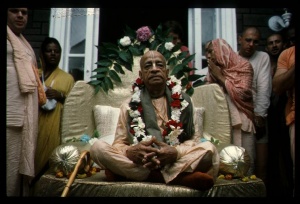CC Adi 13.99 (1975)

A.C. Bhaktivedanta Swami Prabhupada
TEXT 99
- sei-kāle nijālaya, uṭhiyā advaita rāya,
- nṛtya kare ānandita-mane
- haridāse lañā saṅge, huṅkāra-kīrtana-raṅge
- kene nāce, keha nāhi jāne
SYNONYMS
sei-kāle—at that time; nija-ālaya—in His own house; uṭhiyā—standing; advaita—Advaita Ācārya; rāya—the rich man; nṛtya—dancing; kare—performs; ānandita—with joyful; mane—mind; haridāse—Ṭhākura Haridāsa; lañā—taking; saṅge—with Him; huṅkāra—loudly; kīrtana—saṅkīrtana; raṅge—performing; kene—why; nāce—dances; keha nāhi—no one; jāne—knows.
TRANSLATION
At that time Śrī Advaita Ācārya Prabhu, in His own house at Śāntipura, was dancing in a pleasing mood. Taking Haridāsa Ṭhākura with Him, He danced and loudly chanted Hare Kṛṣṇa. But why they were dancing, no one could understand.
PURPORT
It is understood that Advaita Prabhu, at that time, was in His own paternal house at Śāntipura. Haridāsa Ṭhākura frequently used to meet Him. Coincidentally, therefore, he was also there, and upon the birth of Śrī Caitanya Mahāprabhu both of them immediately began to dance. But no one in Śāntipura could understand why those two saintly persons were dancing.